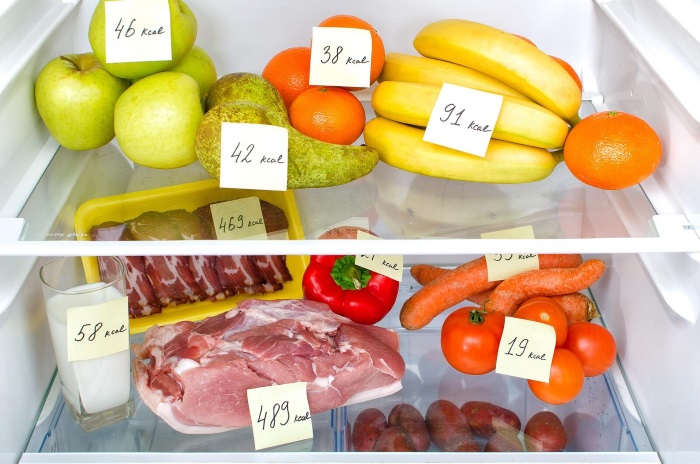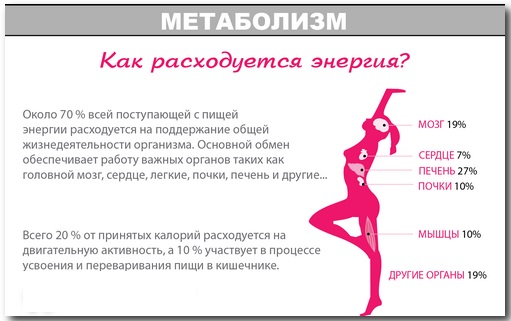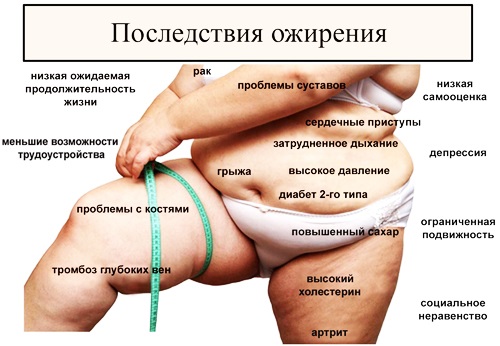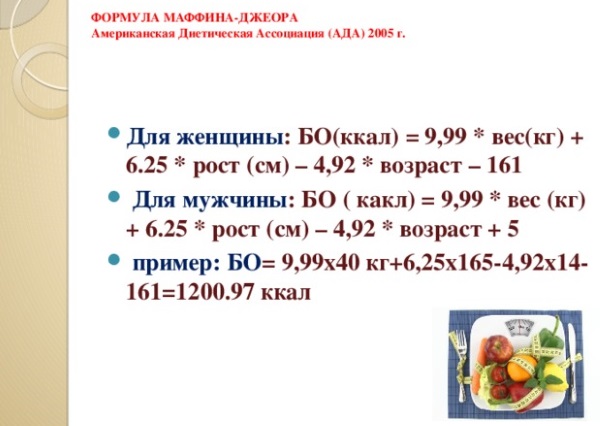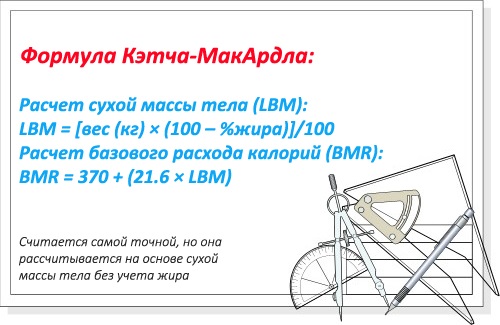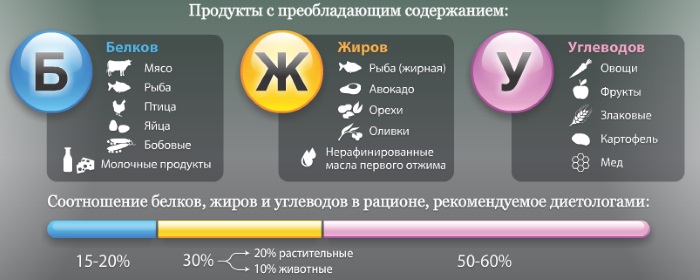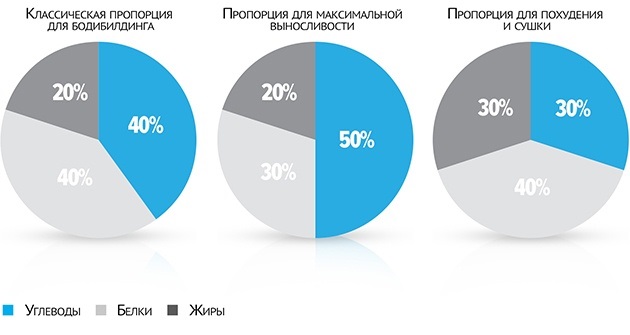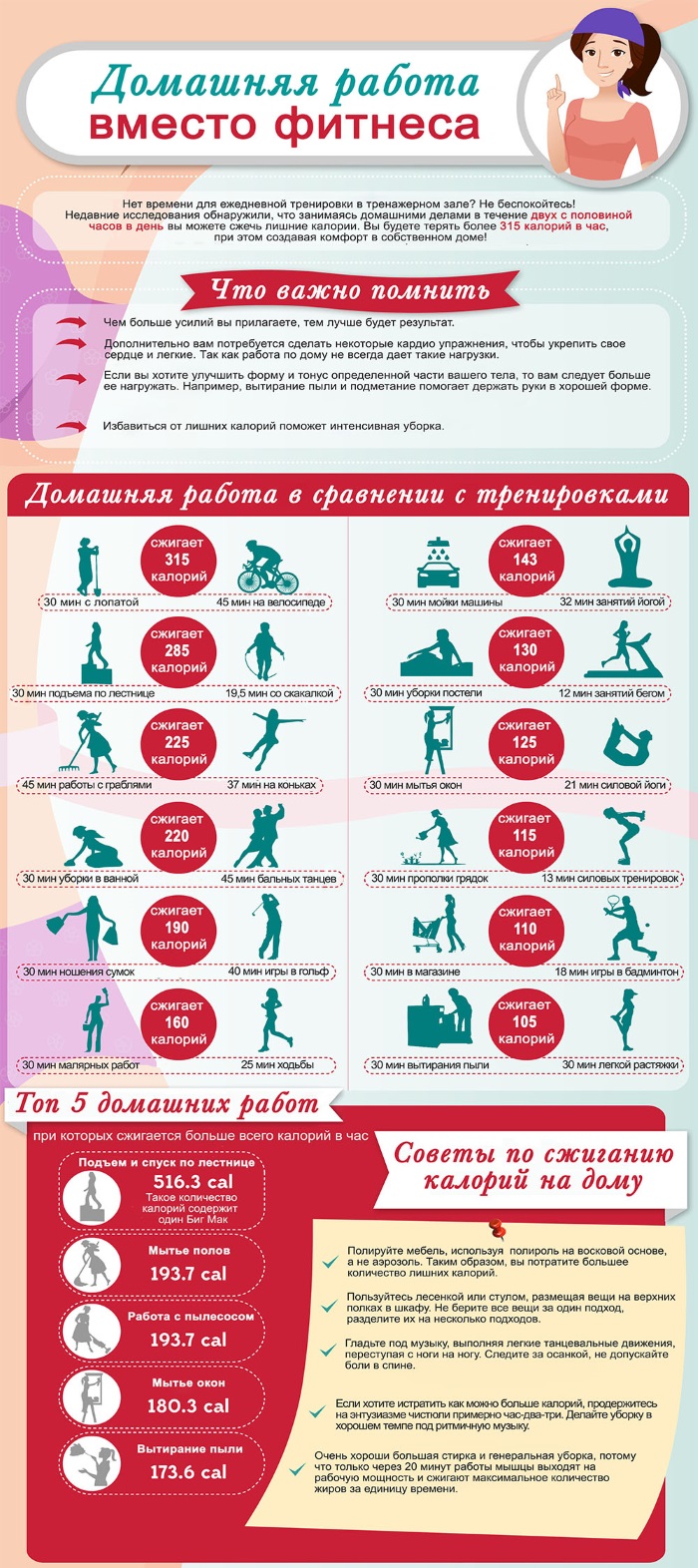In the modern world, more and more attention is paid to a healthy lifestyle. The media promote sports, tell amazing stories of people who were able to lose weight, show materials about the consequences of malnutrition. Whatever goal a person asks for, you need to start by establishing the daily calorie intake per day.
What is the calorie content of foods, why is it needed?
The calorie content of foods (energy value) is the amount of energy that is produced after the digestion and complete assimilation of food.
The unit of measurement of energy value is kilojoule (kJ) or kilocalorie per 100 g of food. All foods have calories. But such as black tea, dried dill are insignificantly high-calorie foods.
Calories are found in proteins, fats, and carbohydrates. Proteins provide energy and metabolism. Fats break down into acids and glycerin, turning into energy. Carbohydrates provide energy for biochemical processes. Therefore, a calorie is needed to live, breathe, move, and maintain blood circulation.
Healthy and unhealthy calories
Calorie is a unit of measurement of heat, energy. They are usually divided into useful and harmful, since some of them, entering the body, are beneficial, while others are sent to the reserve.
Most of the calories come from carbohydrates.
Complex carbohydrates are found in:
- cereals;
- vegetables;
- saccharides.
Fast carbohydrates are found in sugar, chocolate and confectionery. In the first case, the body will receive a lot of energy, trace elements, vitamins and amino acids. These are healthy calories.
When simple carbohydrates enter the body, it will receive a significant dose of calories with practically no useful elements, plus they will go to the reserves of adipose tissue. Such calories are called harmful.
Healthy calories come from natural foods, and unhealthy ones come from processed ingredients fortified with flavorings.
Standards for women, pregnant girls
A woman needs less calories than a man.
To calculate the calorie intake per day, they need to take into account:
- activity;
- age;
- individual characteristics;
- health.
With an inactive lifestyle, the rate per day will be:
- from 18 to 24 years old - 1950 kcal;
- from 25 to 49 years old - 1750 kcal;
- over 49 years old - 1550 kcal.
With an average activity level:
- from 18 to 24 years old - 2150 kcal;
- from 25 to 49 years old - 1950 kcal;
- over 49 years old - 1750 kcal.
With an active life:
- from 18 to 24 years old - 2350 kcal;
- from 25 to 49 years old - 2150 kcal;
- over 49 years old - 1950 kcal.
When a woman is carrying a child, it is forbidden for her to lose weight, but eating "for two" can also be harmful. It is necessary to remember the golden rule - "eat not for two, but for two."
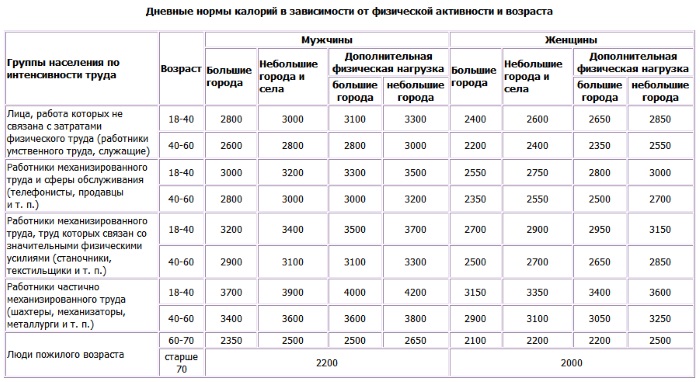
The daily calorie intake per day depends on the duration of pregnancy. With its increase, the consumption of calories should also increase, ranging from 2500 to 3200 - in the last weeks of pregnancy.
So the expectant mother should consume at least 3500 calories per day. Their third part goes to hormonal changes, to provide the fetus with everything necessary, to prepare a woman for future childbirth and breastfeeding.

 Don't miss the most popular column article: Laser hair removal on the face and body - how it is performed, effectiveness, before and after photos, contraindications.
Don't miss the most popular column article: Laser hair removal on the face and body - how it is performed, effectiveness, before and after photos, contraindications.Norm for men
The daily calorie intake per day for males is much higher. To correctly calculate the energy requirement for a man, you need to know his lifestyle and the number of full years.
| 25 years | 26-45 | more than 45 |
| inactive | ||
| 2300 kcal | 1900 kcal | 1600 kcal |
| average activity | ||
| 2450-2700 kcal | 2450 kcal | 2250 kcal |
| active | ||
| 3150 kcal | 2950 - 3150 kcal | 2550 - 2950 kcal |
If a man wants to lose extra pounds, the daily calorie intake should be reduced, and with muscle building, increased.
Norms for children and adolescents
The diet of children and adolescents should be varied and complete, since in the adolescent body there are large hormonal changes, body growth. The daily calorie intake for the younger generation should take into account its physical activity - engaging in various sports, psychological stress, physical and mental stress per day.
If a girl is active, her rate will be between 1800-2100 kcal. For an active young man, the norm is 2200-2500 kcal. When the guys are inactive, the calorie intake should not be more than 2000 kcal.
The daily calorie intake for children is determined by age. A small growing organism needs to be provided with a sufficient amount of energy. The growth process of children is fast, so every 6 months the calorie content must be adjusted.
Taking into account age, the need looks like this:
- from 12 months to 1 year 11 months - 1250 kcal;
- from 1 year 11 months to 3.5 years - 1450 kcal;
- from 3.5 to 6 years old - 1850-2000 kcal;
- from 6 to 9 years old - 2000-2400 kcal;
- from 9 to 13 years old - 2850 kcal.
It is not necessary to bring the calorie intake to the norm by the increased use of flour, confectionery, soda and other products containing a lot of sugar.
This can lead to the appearance of:
- gastritis;
- being overweight;
- allergies.
Lower limits of the norm
The calorie corridor is the lower and upper limit of the consumption of calories per day to reduce or maintain weight. Knowing the lower limit will help to know the individual level of metabolism (basic metabolism). There are many equations for calculating metabolic rate. Add 200 to the result of the lower limit of the norm, and you get the upper limit.
To lose weight, you need to calculate the individual calorie corridor and begin to reduce it. Doctors advise not to let go less than the lower limit of the norm - 900-1000 calories per day. If losing weight uses less, then he will constantly feel hunger and stressed. In this case, weight loss will stop, since the body will leave energy in reserve.
Why stick to your daily calorie intake
Basal metabolism is the metabolism that occurs while a person is asleep or at rest.
Calorie consumption is spent on natural physiological processes:
- breath;
- circulation;
- maintaining the temperature regime;
- the growth of new cells.
Therefore, when calculating the metabolism at absolute rest, the need for calories for active physical activity is not taken into account.
Proteins, fats and carbohydrates, getting into the body, provide the work of all organs, release energy for solving everyday tasks and actions. Endowing the body with the required amount of calories, a person greatly facilitates the work of the entire human mechanism. The body will respond with health, endurance, resistance to bacteria and a good mood.
Consequences of insufficient and excess calorie intake
Insufficient or excessive consumption of calories can be asymptomatic, and can lead to the appearance of visible diseases and the development of pathological conditions of the body.
Insufficient nutrition can lead to:
- decreased immunity;
- diseases against the background of the psyche;
- problems with the stomach and intestines;
- oncological diseases;
- violations of the physical development of children and others.
The consequences of eating too much:
- obesity;
- diabetes;
- diseases of the heart and blood vessels;
- atherosclerosis and others.
To prevent these consequences, you need to balance the diet, replace high-calorie foods with low-calorie foods, combine proper and balanced nutrition with exercise and being in the fresh air.
Calculation of the norm by the Muffin-Geor formula
In 2005, the Muffin-Geor formula was introduced to calculate the calorie intake per day. The equation was introduced by a team of American dietitians under the leadership of distinguished doctors - Muffin and San Geor. The formula is based on calculating the calorie requirement to maintain current weight based on activity.
There is a theory in 2 forms - simplified and modified:
1. The simplified method shows the calories for the metabolism of men (OOM) and women (OOL):
OOM = (10 * kg (weight)) + (6.252 * cm (height)) - (5 * age) + 5;
OOL = (10 * kg (weight)) + (6.252 * cm (height)) - (5 * age) - 162.
2. The modified Muffin-Geor equation presents a clearer figure of calories, taking into account daily physical exertion - the result of OOM and OOL is multiplied by physical activity.
Activity is divided into 5 steps depending on physical activity:
- 1.2 - small;
- 1.38 - weak;
- 1.55 - moderate;
- 1.73 - large;
- 1.9 - super large (includes people who physically work and exercise every day).
Harris-Benedict formula
The Harris-Benedict equation has been very popular for many decades and has earned the approval of experts. It was founded in 1919. Due to its simplicity, the formula is able to determine the individual rate in calories.
The equation calculates the required caloric volume for metabolism (BOO). Then it becomes obvious how much less calories you need to eat in order to start losing weight.
HEI on the Harris-Benedict theory (age - full years, height - centimeters, weight - kilograms):
- female gender: BOO = 655.2 + 9.61 * weight + 1.851 * height - 4.69 * age;
- male gender: BOO = 66.48 + 13.76 * weight + 5.01 * height - 6.75 * age.
In 1984, the equation was revised and corrected, in connection with innovations in medicine and people's lifestyle:
- female gender: BOO = 447.594 + (9.248 * weight) + (3.099 * height) - (4.331 * age);
- male gender: BOO = 88.363 + (13.398 * weight) + (4.798 * height) - (5.678 * age).
Ketch-McArdle Formula
The Ketch-McArdle equation is based on calculating lean body mass, which makes it possible to more accurately determine the caloric requirement per day. The calculation is based on muscle mass (MMT), so it is equally suitable for both males and females.
Base metabolism = 370 + 21.6 * muscle mass.
For example, for a person weighing 53 kg, with a fat share of 20% (10.6 kg of fat), which means that the body weight without fat will be 53 - 10.6 = 42.4 kg caloric requirement per day will be:
370 + (21.61 * 42.4) = 1286 calories
In this case, the activity should be taken into account, for example, it will be equal to 1.55 (training or physical work more than 2 times a week). Caloric requirement per day = 1.55 * 1286 = 1993 calories.
WHO formula
The World Health Organization's equation is based on daily calorie requirements based on activity (weight in kilograms).
For girls and women of age:
- 18 - 29: kfa * (0.0641 * weight + 2.038) * 241;
- 30 - 60: kfa * (0.035 * weight + 3.540) * 241;
- over 61: kfa * (0.039 * weight + 2.756) * 241;
For boys and men of age:
- 18 - 29: kfa * (0.064 * weight + 2.897) * 241;
- 30 - 60: kfa * (0.485 * weight + 3.654) * 241;
- over 61: kfa * (0.493 * weight + 2.460) * 241.
CFA is activity, it can take the meaning:
- 1 - low, minimal loads;
- 1.3 - average, training from 2 times a week, work of moderate severity;
- 1.5 - high, physical work, regular sports.
For example, a 28-year-old girl weighing 48 kg with a high CFA level needs: (0.064 * 48 + 2.038) * 241 x 1.5 = 1847 kcal.
Body area formula
The formula is based on knowledge of the person's height and weight. Tall and thin people will have a higher basic metabolic rate. If an equal volume of calories daily will be consumed by people with the same weight, but different in height (low and high), then after a certain time a person of short stature will gain weight. In this case, a large person will remain with the same weight.
Calorie consumption per 1 sq. m body area per hour:
| Age | Calories |
| 14-16 | 43 |
| 16-18 | 40 |
| 18-20 | 38 |
| 20-30 | 37 |
| 30-40 | 36,5 |
| 40-50 | 36 |
| 50-60 | 35 |
| 60-70 | 34 |
| 70-80 | 33 |
BJU norms per day for women, men and children
Proteins, carbohydrates, and fats are important ingredients in food. When following a diet and calculating calories, their ratio must be taken into account.
When determining the BZHU norm, a person is defined in one of the following weight categories:
- Category 1 - body weight in the range of 30-50 kg;
- 2nd category - 51-60 kg;
- Category 3 - 61-70 kg;
- 4th category - 71–90 kg.
The norm of carbohydrates:
| Category 1 | Category 2 | Category 3 | 4 category | |
| maintaining weight | ||||
| men | 220 g | 235 g | 255 g | 265 g |
| women | 155 g | 195 g | 205 g | 225 g |
| diet | ||||
| men | 163 g | 168 g | 178 g | 188 g |
| women | 135 g | 145 g | 160 g | 170 g |
| for muscle growth | ||||
| men | 280 g | 295 g | 325 g | 340g |
| women | 210 g | 255 g | 270 g | 255 g |
Protein norm:
| Category 1 | Category 2 | Category 3 | 4 category | |
| maintaining weight | ||||
| men | 150 g | 160 g | 170 g | 180 g |
| women | 125 g | 135 g | 145 g | 155 g |
| diet | ||||
| men | 155 g | 160 g | 165 g | 175 g |
| women | 110 g | 135 g | 155 g | 145 g |
| for muscle growth | ||||
| men | 185 g | 195 g | 205 g | 215 g |
| women | 165 g | 175 g | 190 g | 195 g |
Fat rate:
| Category 1 | Category 2 | Category 3 | 4 category | |
| maintaining weight | ||||
| men | 45 g | 55 g | 55 g | 60 g |
| women | 40 g | 45 g | 45 g | 50 g |
| diet | ||||
| men | 25 g | 25 g | 25 g | 25 g |
| women | 25 g | 30 g | 30 g | 35 g |
| for muscle growth | ||||
| men | 65 g | 65 g | 70 g | 75 g |
| women | 55 g | 55 g | 60 g | 65 g |
Age influences BJU norms for children:
| Age (years) | Proteins, g | Fat, g | Carbohydrates, g |
| 1-3 | 54 | 54 | 212 |
| 4-6 | 69 | 69 | 272 |
| 7-10 | 77 | 79 | 335 |
| 11-13 boys | 90 | 92 | 390 |
| 11-13 girls | 82 | 84 | 355 |
| 14-17 boys | 98 | 100 | 425 |
| 14-17 girls | 90 | 90 | 365 |
Food should be balanced for both adults and children. Excess or deficiency of BJU affects health and well-being.
Individual calculation of BZHU
To calculate the individual level of BJU, you need to calculate your metabolic rate according to one of the formulas of well-known doctors and nutritionists.
It is known that in 1 g:
- protein - 4 kcal;
- fat - 9 kcal;
- carbohydrates - 4 kcal.
And the proportion of BJU in the recommended diet looks like this:
- 27% proteins;
- 23% fat;
- 50% carbohydrates.
Based on this, an individual BJU is considered (take the number of calories for the basic metabolism, equal to 1250):
- Protein = (1250 * 0.27): 4 = 84 g.
- Fat = (1250 * 0.23): 9 = 32 g.
- Carbohydrates = (1250 * 0.50): 4 = 156 g.
The diet should be formulated taking into account goals and calorie needs, while maintaining a balanced ratio of BJU.

 Don't miss the most popular column article: Morning exercises for those over 40, 50. Gymnastics exercises for weight loss, video tutorials.
Don't miss the most popular column article: Morning exercises for those over 40, 50. Gymnastics exercises for weight loss, video tutorials.How many calories do you need to lose weight or build muscle?
The daily calorie intake per day is individual for everyone and depends on the lifestyle. And the purpose of calorie counting is also different, one for dieting, the other for building muscle.
Modern nutritionists allocate a figure of 1000-1200. This is how many calories a woman and a girl need per day to provide the female body with everything it needs. For men - 1200-1500 kcal. By reducing these indicators, you can start losing weight. It is not recommended to drastically reduce calorie intake, you need to gradually by 20%.
Proteins are responsible for the growth of muscles in the body, fats are responsible for stabilizing the fat layer, carbohydrates are responsible for the production of the necessary energy. The required calorie content of food depends on a specific sport and is calculated per kilogram of body weight. When the goal is weight gain, the calorie requirement should be 50-63 kcal per kilogram of body weight.
Weight loss and gain rate
Excess weight is dangerous for a person, but a sharp decrease in it is also undesirable. Modern nutritionists believe that losing weight per kilogram in the first week of dieting will not harm the body. But weight loss should come not only thanks to dietary nutrition, but also to sports and an active lifestyle.
In the first 2 weeks, water leaves, not fat reserves.Further, it is recommended to lose weight no more than 600 g per week. For weight loss to go faster, you need to consume more complex carbohydrates, while the calorie consumption should be higher than the intake.
A sharp decrease in weight does not allow the body to adapt to new conditions. There is a decrease in metabolic rate and a negative effect on the liver and kidneys. And the rapid loss of fluid - to skin flabbiness, to convulsive processes in the muscles and heart.
If you want to gain weight, doctors recommend sticking to the figure of 3 kg per month. A large increase has a negative effect on the work of the whole body and a person's well-being.
Medical and nutritional advice on organizing calorie-based menus
Doctors and nutritionists recommend keeping a notebook when calculating calories. In it, you need to plan your meals for every day, taking into account the recommended use of BJU, and also calculate the excessively accumulated stocks, or the desired kilograms. Proper nutrition must be accompanied by a psychological attitude towards the benefits and benefits.
Nutritionists support the idea that a person should not limit himself to any foods. The whole point of diet and weight gain should be based on calorie counting. You should not start a diet for any illness, stress, difficult periods of life.
Recommendations for organizing the menu:
- the daily food intake should be divided by 4 times, with breaks between them from 3 to 4 hours;
- reduce the consumption of smoked meats, pickles;
- the final meal should be 2.5 hours before bedtime (better earlier);
- the norm for the use of simple carbohydrates (pasta, confectionery);
- the distribution of calories should be as follows: breakfast - 30%, light snack - 10%, lunch - 40%, dinner - 20%, 5-10% - additional dinner;
- half an hour before eating, drink a glass of water.
Knowing the daily calorie intake per day, it is not difficult to adjust the diet and begin the path to achieving the desired goal - gain or loss of weight. Calculating the calorie content of foods will help you look at nutrition differently and balance your life.
Article design: Vladimir the Great
Video on the topic: Daily calorie intake for a person
How to calculate the daily calorie intake for men and women:


